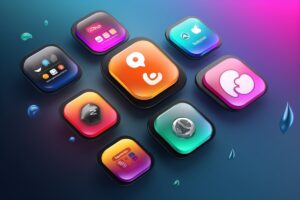In the rapidly evolving world of mobile app development, user experience (UX) stands as a beacon of importance. This remains especially true for platforms like iOS, where the expectations for quality and innovation are perpetually high. Drawing insights from seasoned iOS engineers, we explore various facets of what makes a superior UX on iOS devices, ensuring our narrative transcends the mundane and presents a humanized viewpoint on technological advancements.
In this article, we have focused on the user-centric aspect of app development and how machine learning (ML) has amplified its impact in recent years. Delved into the possibilities opened by Core ML for personalized user experiences and provided examples of popular apps that use it.
Now shift our focus to other critical elements that contribute to a holistic UX, namely user testing and feedback. We will also recap some of the key insights shared by iOS engineers throughout this article and provide recommendations for further learning.
1. Understanding User Expectations in the iOS Ecosystem
The iOS ecosystem, characterized by its exclusivity and innovation, sets a high bar for user expectations. Users typically look for apps that are not only aesthetically pleasing but also intuitive, reliable, and secure. They expect seamless integration with the broader ecosystem of Apple products and services, emphasizing the importance of privacy and data protection.
iOS engineers leverage these expectations as a guiding beacon in their development process. This approach ensures that the apps they create not only meet but often exceed user expectations. By prioritizing features such as Touch ID, Face ID, and seamless handoff between devices, developers can craft apps that integrate deeply into the user’s daily life, thereby elevating the overall user experience.
2. Design Principles for Enhanced User Experience
Apple’s design principles articulated through its Human Interface Guidelines, advocate for clarity, deference, and depth in design. These principles emphasize the importance of creating an intuitive user interface that foregrounds content and functionality while fostering a sense of depth through layered interfaces and motion.
A prime example of these principles in action is the Health app, which uses clean lines and a minimalist design to present complex health data in an easily digestible format. The use of color to signify different health categories and metrics, coupled with interactive charts and graphs, exemplifies how design can enhance usability and user engagement.
According to a 2021 report by Sensor Tower, health and fitness apps saw a 56% increase in downloads, underscoring the significant role of user-focused design in driving app popularity.
3. Leveraging Latest iOS Features to Improve UX
iOS updates are more than mere improvements; they’re opportunities for developers to enrich user experiences significantly. Through insights into recent iOS features, iOS engineers reveal how these updates can be a goldmine for enhancing UX. Real-world examples include apps that have ingeniously leveraged augmented reality (AR) capabilities and Siri shortcuts to offer users a more interactive and personalized experience. Such initiatives open up a world of possibilities for creating immersive and engaging user experiences that go beyond traditional touch-based interactions.
In addition, updates like Dark Mode and Haptic Touch provide ways to improve accessibility and make the interface more convenient for users. The use of these features not only promotes inclusivity but also adds a touch of novelty to the user’s experience.
4. The Role of Accessibility in User Experience
Accessibility is not an afterthought but a key component in creating inclusive apps that cater to all users. Interviews with iOS engineers illuminate the significance of embedding accessibility features right from the design phase. Practical tips shared include using dynamic type sizes, voiceover capabilities, and ensuring color contrasts meet accessibility standards, thereby guaranteeing that apps are usable by people with various disabilities. The impact of accessibility on user experience cannot be overstated, as it opens up the app to a wider audience and promotes inclusivity.
Moreover, iOS engineers share how they continually work towards improving accessibility by incorporating feedback from users and conducting regular audits. This approach not only drives continuous improvement but also showcases a commitment to providing an inclusive user experience for all.
5. Personalization and Machine Learning
The magic of personalization through machine learning (ML) is transforming how users interact with iOS apps. By leveraging Core ML, iOS engineers are tailoring experiences to individual user preferences and behaviors. Examples include recommendation engines in shopping apps and personalized content feeds in social media apps, which significantly elevate the user’s engagement and satisfaction.
ML also plays a crucial role in making apps more accessible. For instance, speech recognition technology assists users with motor disabilities by allowing them to interact with apps using their voice. Additionally, facial recognition and eye tracking can help users with visual impairments navigate through the app interface seamlessly.
6. Optimizing Performance for Smooth User Experiences
App performance is a critical component that can dramatically influence user experience. iOS programmers and engineers emphasize the importance of optimizing app performance to ensure smooth, responsive interactions. Key strategies include minimizing load times, reducing energy consumption, and ensuring that animations and transitions are fluid. By leveraging the powerful tools provided by the iOS platform, such as the Instruments app for analyzing performance metrics, developers can identify bottlenecks and optimize accordingly.
iOS engineers also advocate for a proactive approach to performance optimization, incorporating best practices such as efficient memory management, leveraging the latest iOS APIs for performance enhancements, and regularly testing app performance across different devices and iOS versions.
7. Testing and Feedback – Iterating Towards Perfection
User testing and feedback are invaluable in the iterative process of app development. This section discusses strategies for collecting and implementing user feedback, emphasizing the role of analytics, beta testing, and direct user surveys. iOS engineers recount success stories where user feedback directly influenced significant improvements in app UX.
Developers must also consider accessibility when testing and gathering feedback, ensuring that the app is usable and optimized for all users, including those with disabilities. This includes considering factors such as font size and color contrast, as well as incorporating assistive technologies like VoiceOver or Switch Control.
Conclusion
Reflecting on the insights offered by iOS engineers, it’s evident that UX is not merely an aspect of iOS app development but its very heartbeat. From leveraging the latest iOS features and ensuring accessibility to harnessing the power of machine learning for personalization, optimizing performance, and valuing user feedback, the path to elevating user experiences is multifaceted and dynamic. Because at the end of the day, it’s not just about building apps; it’s about creating experiences that resonate, engage, and uplift. So, contact us today and join the ranks of iOS engineers spearheading the evolution of user-centric app development. Let’s elevate UX together!







+ There are no comments
Add yours